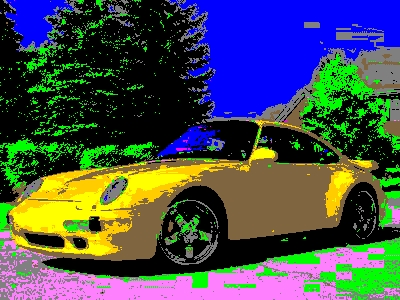Color Naming
Learning Color Names from Real-World Images


 In general, research on color naming applies the following paradigm:
a collection of color chips is labelled with color names
within a well-defined experimental setup by multiple test subjects.
The collected data set is subsequently used to
label RGB values in real-world images with a color name.
Apart from the fact that this collection process is time consuming,
it is unclear to what extent color naming within a controlled setup is representative for color naming in
real-world images. As an alternative method we investigated learning color names from real-world images. For this purpose we used images
collected with Google Image.
In general, research on color naming applies the following paradigm:
a collection of color chips is labelled with color names
within a well-defined experimental setup by multiple test subjects.
The collected data set is subsequently used to
label RGB values in real-world images with a color name.
Apart from the fact that this collection process is time consuming,
it is unclear to what extent color naming within a controlled setup is representative for color naming in
real-world images. As an alternative method we investigated learning color names from real-world images. For this purpose we used images
collected with Google Image.
The car-image on the right shows an example of color naming based on real-world images (second image) and based on color chips labeled in a laboratory setting (third image). The colors indicate the assigned color label: in the second image the whole car is labelled yellow, whereas in the thirs the car is labelled orange, brown, and yellow. Color name labelling based on color chips has the disadvantage that slight color changes are labelled with chromatic color names. For example the white/grey street is labelled as being pink and green. This problem is resolved once learning color names from real-world images.
A tar-file containing the data for color name assignment can be down-loaded: color_naming.tar.
The file contains a matrix mapping sRGB values to the 11 basic color terms of English, and a matlab example on how to apply it for pixel classification.
Color Name Data Sets
 For our research on color names we have collected two data sets. To automatically learn color names we collected a set of 100 images for each of the eleven basic color terms: black, blue, brown, grey, green, orange, pink, purple, red, white, and yellow. The images are collected with Google Image by querying the color term together with the term "color", e.g. for red the query in Google Image is "red+color".
For our research on color names we have collected two data sets. To automatically learn color names we collected a set of 100 images for each of the eleven basic color terms: black, blue, brown, grey, green, orange, pink, purple, red, white, and yellow. The images are collected with Google Image by querying the color term together with the term "color", e.g. for red the query in Google Image is "red+color".
A tar-file containing 1100 color name labelled images:
google_colors.tar
To evaluate color name mappings we have collected a set containing real-world objects accompanied by a color name. The data set contains images collected from EBAY auction site (www.ebay.com). The set contains four classes: cars, shoes, dresses, and pottery. Each class contains 10 images for each of the eleven basic color terms. The color names were assigned to the images by EBAY users.
For each image a hand-segmentation of the object areas which correspond to the color name is provided.
A tar-file containing the ebay images:
ebay_data.tar
Literature
J. van de Weijer, C. Schmid, J. Verbeek, D. Larlus Learning Color Names for Real-World Applications , IEEE Transactions in Image Processing, 2009.
J. van de Weijer, C. Schmid, J. Verbeek Learning Color Names from Real-World Images, Proc. CVPR07, Minneapolis, USA, 2007.
J. van de Weijer, C. Schmid,
Applying Color Names, Proc. CVPR07, Minneapolis, USA, 2007.